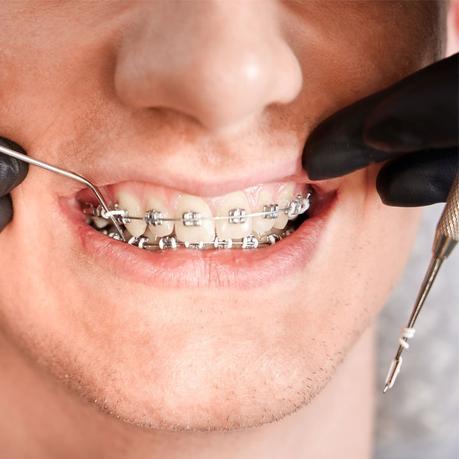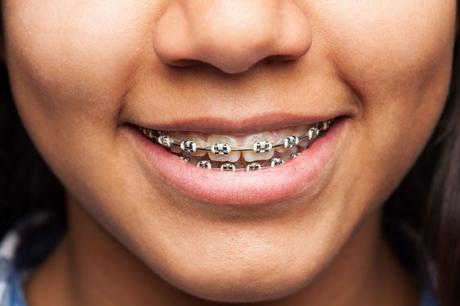
You’re on your way to straighter teeth and a healthier bite when hunger strikes, you may wonder what you can eat. Don’t worry. Eating with dental braces does not require changing your eating habits drastically. Following these eating tips will help with the effectiveness of your orthodontic treatment.
1. Start with soft foods
When your braces are first put on, your teeth may feel sore within a few hours. This is normal. It means your dental braces are working. Make sure to eat soft foods. Think fruit smoothies, pasta, mashed potatoes, and rice.
2. Cut your food up into small pieces
A knife and fork will be your best friends from now on, as it’s essential to cut all of your food into small pieces.
3. Avoid biting into food with your front teeth, like apples, sandwiches, hamburgers, and corn on the cob; instead, cut it up. Chew using your back teeth as they have a larger bite surface.
4. Avoid hard food
Steamed hard vegetables like carrots. Watch out for croutons and bacon bits and salads, and cut corn off the cob. Avoid beef jerky, popcorn, and hard candy. And avoid chewing on non-food items like ice, pencils, and pens.
5. Avoid sticky food
Don’t chew bubblegum, toffee, and caramel.
6. Make sure to brush your teeth after you eat anything sugary
If you don’t have a toothbrush handy, swish water in your mouth to help get rid of some of the sugar. And make sure to brush as soon as you can. Remember, drinks like juice and pop, even milk, all have sugar. Now you understand that braces do not require drastically changing your eating habits.
Foods To Avoid With Dental Braces
Getting dental braces isn’t easy to adjust to. You have to get used to that new metal mouth look, the pain, the frequent visits to your orthodontist that sometimes cause even more pain and on top of all that, you have to make some changes to your diet. Now for the first week or so, your teeth will be sore, and you’ll probably want to stick to softer foods that are easier to eat. But once you get used to your braces, your cravings for all your favorite foods will probably come back, and this is where you’ll have to control yourself. Some of you probably learned this the hard way and ended up with a bracket that came loose or a wire that started poking at your cheek. But don’t worry, you know what foods to avoid when you have braces.
Types of Foods To Avoid While Wearing Eat With Dental Braces
- The first type of food you want to avoid is sticky food. These are things like toffee, caramel, and budge. You know, all the good stuff. And you can probably guess why these foods can get stuck on your braces, and there’s a chance they can loosen or even pull off one of your brackets. No matter how bad you want them, it’s best to hold off your temptations until after you get your braces off.
- The second food you want to avoid is sugary foods. The dentist always wants you to eat less sugar, but it’s essential with braces. Wearing braces means more areas for bacteria to build up in your mouth. In other words, it means your teeth are harder to clean. So if you eat lots of sugary foods with your dental braces, there’s a chance some of these bacteria can find their way under one of your brackets and cause a cavity.
- Number three hard foods. This includes biting into an apple, eating whole carrots and chewing on ice. First, you shouldn’t be chewing ice in the first place. But that’s beside the point. When you bite into hard foods like these. there’s a chance one of your brackets can break off, and you’ll have to go back to your orthodontist to get it fixed. It’s better to break up your food into smaller pieces when you can.
Our fourth food to avoid is popcorn.
Popcorn gets stuck in everything. So there’s a good chance you’ll get popcorn stuck in your dental braces if you eat it. Not only will you have a hard time cleaning them out. There’s a good chance you could damage your wires when you do.
Our fifth and final food to avoid is soda and fruit juices.
Not only are these drinks loaded with sugar, but they are also very acidic and can damage your teeth if you drink them frequently. So what happens if you eat some of these foods? Well, there’s no guarantee. You might get lucky and never damage your dental braces, but you don’t want to risk it.
Imagine going on vacation only for it to be ruined because the wires for your dental braces come loose, and they were poking at your cheeks the whole time out. If you do have problems with your braces. You should give your orthodontist to visit as soon as possible so you can get it fixed. And don’t forget proper oral hygiene is especially important when you have braces. So always ensure you take care of your teeth at home and visit your dentist every six months.
QUALITY AFFORDABLE DENTAL IMPLANTS
Copperhills Family Dentistry specialists provide specialized dental services that help our patients cultivate healthy and happy smiles. We’re happy to provide compassionate care coupled with cutting-edge technology.
dental implant TeethWhitening cosmetic
dentistry dental cleaning
and checkups
How To Deal With Dental Braces Discomfort
Once your braces are on, you may feel tightness and soreness within about three to four hours. This is normal. It means your braces are working.
Discomfort can arise from the following:
Brackets Rubbing
Brackets can rub against the inside of your mouth or if you have lingual braces. They may rub against your tongue. This can cause soreness. To help protect your cheeks and tongue, use the wax that your orthodontist has provided you to cover the bracket or brackets causing you pain. Make sure the bracket is very dry before applying the wax. This soreness will go away after a few days. This amount of time will vary from individual to individual. If you feel the need to check with your orthodontist’s office. Don’t hesitate to call. Discomfort can also arise from a wire poking as your teeth start to move, and straightening the wire that connects your brackets will shift further toward the back of your mouth. It can then start to poke the back of your cheek. Apply wax to the end of the wire to minimize discomfort, and call your orthodontist’s office to book an appointment to have this fixed.
Wire Comes Out of a Bracket
Wires are fragile at the start of treatment, so they can quickly shift and possibly come out. This is most common with the back brackets. Don’t try to fix this. Call your orthodontist’s office to book a time to have it adjusted.
Bracket Falls Off
Most of the time, it will dangle or spin on the wire. It may also fall off entirely and leave it alone. It’s essential to call your orthodontist’s office and let them know.
If you have an appliance and anything goes wrong with it, make an appointment to have it fixed. That’s it. Remember it’s essential to deal with braces discomfort promptly and not to panic.

Life with Dental Braces - Brushing and Flossing
After eating with your braces, the plaque will build up around the bands and brackets and along the gum line. Our objective is to thoroughly remove all of it. With the brush bristles angled approximately 45 degrees downward, make small circular motions while moving the brush forward. Angle the brush bristles approximately 45 degrees upward and make small circular motions while moving the brush forward.
Using the same brush, head angles and motion, clean the remaining teeth until all buildup is removed.
The proxy brush is a nylon bristled brush intended to clean between teeth. Place it under the archwire between two teeth, then move it up and down, cleaning the edge of the bracket toward the back between the two teeth and then the edge of the bracket toward the front. Pass the floss and threader up between two teeth. Slide the floss back and forth several times, cleaning the surfaces of these teeth. Be sure to clean below the gum line. The floss and threader upwards from inside and below the archwire for the lower pass. Again be sure to clean below the gum line. Remove the floss and threader.

